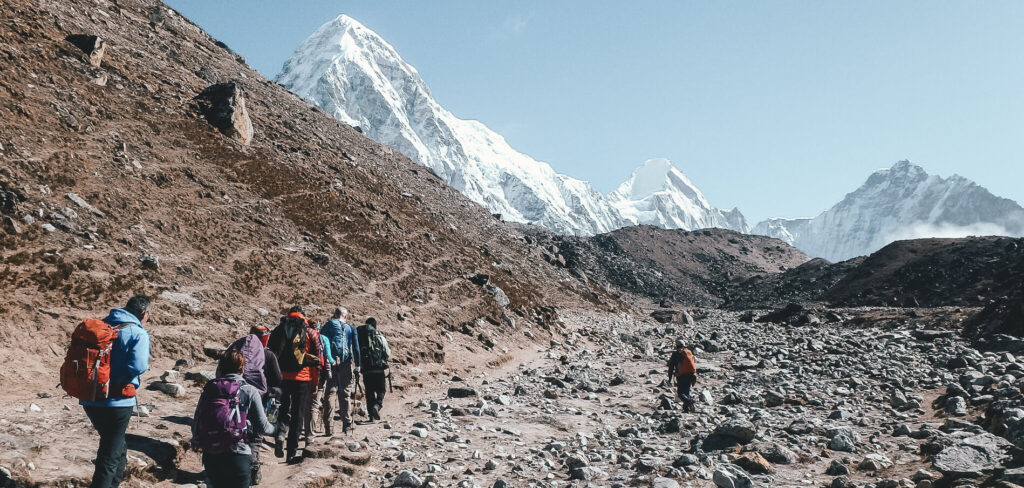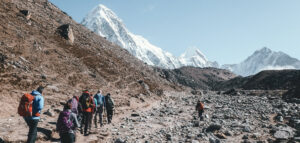
Everest Base Camp Trek Landing at Lukla Airport is the start of one of the world’s greatest adventures, which is the trek to Everest Base Camp. Officially named Tenzing-Hillary Airport, Lukla sits at an elevation of 2,845 meters in Nepal’s Khumbu region. The airport is kilometre-high in the Himalayas and is known for a short, sloped runway, which is flanked on one side by high mountains. It is labelled by many as one of the world’s most dangerous airports. Despite its notoriety, thousands of trekkers are able to fly in and out of Lukla safely each year, and it’s a main jumping-off point for those trekking to Everest. Knowing how to get around this special airport is one way to make sure your trip gets off on the right foot.
Flights to Lukla typically originate in Kathmandu, but in peak trekking seasons, such as autumn and spring, they are often redirected to take off from Manthali Airport in Ramechhap because of air traffic controls in the capital. Manthali can be reached by a grueling early morning to five-hour drive from Kathmandu, arranged by trekking companies. At the airport, travelers then take small planes operated by domestic airlines such as Tara Air or Summit Air. The short runway and tricky mountain approach are something these planes are built for, though flights are highly weather-dependent. The morning departures are the most dependable, because the clouds and wind develop throughout the day, and delays or however many cancellations are common.
At the airport, things are pretty simple, but it can seem like organized chaos given all the trekkers and tight flight schedules. Security checks are easy, and typically, boarding is from the tarmac straight onto the plane. It’s not uncommon for flights to be delayed without warning, so be prepared to be patient and flexible. Now, for a most eight minutes only we can have the baggage. As if no excuse would be valid for picking this little something up. It’s 184cm or a little shorter. For this little something. You’d like to travel light, especially for your hand luggage, and make sure to keep meds ao fuss warm layers, or snacks and essential papers with you. After landing in Lukla, the passengers step out directly onto the runway and take their bags from the open area. The Lukla Airport terminal: small, simple, and barely holding together, but it does the job. Visitors are usually greeted soon outside the terminal by their guides or porters, and it makes for an easy transition into the village and to the trail.
Lukla has a thrilling and memorable approach to landing. It is not only a travel tool, but part of the Everest experience. The steep approach, view of mountain cliffs just outside the window, and the short runway combine to produce a thrilling welcome to the Himalayas. Flight unpredictability is perhaps frustrating, but a natural component of trekking in this area. By being forward-thinking and making sure to build in cushion days both before and after your trek, and by staying in the loop with flight updates, you’ll position yourself to have an easier trip. Lukla is possibly the most famous airport in the world, but adopt the right attitude and it’s a phenomenal gateway to the adventure of a lifetime.
Why is Lukla Airport considered to be dangerous?
Everest Base Camp Lukla Airport, also known as Tenzing-Hillary Airport, is frequently called one of the world’s most dangerous airports. Much of that reputation is derived from a very short runway of some 527 meters (1,729 feet) and the fact that it is surrounded by steep mountainous terrain at a height of 2,845 meters (9,334 feet). At one end of the runway is a rock wall; at the other, a sharp drop into a deep valley. There’s not a lot of margin for error, and planes must land uphill and take off downhill, meaning it’s technically challenging for pilots.
The weather is also a major issue, which cannot be predicted. The landscape is filled with fog, wind, rain, and a constant cloud cover that comes blowing in hungry for destruction and blocks out views of traverse sights and is even known to close the airport with no intention to give a return date. And without advanced navigation aids, pilots must rely on visual flight rules, so if visibility is bad, planes cannot fly.
Despite these difficulties, safety is achieved, and thousands of flights land safely every year thanks to the strict safety regulations and very highly qualified pilots who are trained to land there. While it’s only normal to approach with caution, having a handle on the risks associated with a trepidatious arrival at Lukla can take the edge off — and make it even more exciting.
What if my flight to Lukla is delayed or cancelled?
Everest Base Camp Tour Delays and cancellations on flights to Lukla are widespread, particularly during the monsoon (June to August) and occasionally during the optimal trekking months (spring and autumn). The main cause is erratic mountain weather. Because Lukla functions under visual flight rules, planes cannot land if there is too much cloud cover or if visibility is too poor. Strong winds or fog can keep planes on the ground for hours or days.
Your airline or trekking agency will generally keep you informed about flight delays and try to rebook you on the next available flight. Passengers with trekking groups are frequently given priority rebooking. For solo trekkers, that wait could be longer. If your flight is simply canceled for the day, you will not be taken to your hotel to spend the night, only to return in the morning.
To deal with this uncertainty, it’s strongly recommended to schedule at least one or two buffer days before and after the trek for delays. For those short on time and without the patience to wait out canceled flights, some travelers board helicopters to Lukla, which can take off when planes are grounded. “But that’s far more expensive.
Adaptability and the ability to remain calm when plans change are part of the Everest Base Camp experience.
Is it better to fly to Lukla from Kathmandu or Manthali?
In the high trekking seasons (spring and autumn), the bulk of the flights to Lukla are redirected from Kathmandu to Manthali Airport in Ramechhap district, an airport around 4–5 hours east of Kathmandu by road. It is a move being made by Nepal’s Civil Aviation Authority to ease pressure on the crowded Tribhuvan International Airport in Kathmandu.
There are good and bad sides to flying out of Manthali. On the plus side, the route is more direct, the weather tends to be better, and flights from Manthali to Lukla are more reliable in departing on time. The only downside is the road transfer early in the morning to get to Manthali. Many travelers leave Kathmandu at midnight or 2 a.m. to make early morning flights from Manthali, which means a very long, very tiring beginning to the trek.
If, on the other hand, you’ve booked your flight during the off-season (think winter or summer), your flight will probably leave directly from Kathmandu. This is much easier, but more subject to delays, as the city’s busy airspace and mercurial weather interfere.
If you’re booking a trekking package, your operator will manage the logistics. If you’re traveling on your own, make sure to verify your departure airport and plan your schedule accordingly.
What papers are required for Lukla Airport?
Everest Base Camp Hike But when flying from Kathmandu to Lukla, especially as a foreign tourist, you are going to be taking a few crucial documents with you. The most important of these are your passport, boarding pass or flight ticket, and your TIMS card (Trekkers’ Information Management System), as well as your Sagarmatha National Park Permit or Khumbu Pasang Lhamu Rural Municipality Permit, depending on where your trek starts on this trail. They are mandatory to enter the Everest area and are checked at different control points on the trek.
At the airport itself, you’ll need your passport to check in and to check that your ticket is valid in Kathmandu or Manthali. Domestic flights in Nepal are not as stringent as international flights, but authorities still demand identification, especially from tourists. Trekking permits are not usually checked at the airport, but you must carry them with you as they will be checked soon after you arrive in Lukla.
Also, carry with you the printed or digital copies of your booking confirmation and the contact information for your guide or agency. Although most teahouses and lodges along the trail don’t ask for identification to stay the night, these documents ensure you won’t have any trouble when it comes time for airport check-in, entering the trail, or in the case of an emergency.
How much baggage can I take on the Lukla flight?
Because the Lukla route is served by small aircraft (most often Twin Otters or Doriers), tight baggage restrictions are necessary for safety. You get 10 kg (22 lbs) of checked baggage and 5 kg (11 lbs) of hand carry for a total of 15 kg (33 lbs) as the normal allowance. That includes your backpack, duffel bag (anything you bring), and any kit you are wearing.
Extra luggage is normally priced by the kilo, and the cost differs depending on the carrier. But it’s not a sure thing that your excess baggage will be accepted, particularly if the flight is full or reaching its weight limit. That’s also the reason why it is highly recommended to pack smart and within the allowable limit.
Many trekking agencies assist by either sending extra baggage with porters or keeping it in Kathmandu. If you’re traveling with photography equipment, a drone, or additional cold-weather gear, think through how you’ll pack these items.
Your hand-carry must contain all the important things – valuables, medicines, money, documents, and a warm jacket / as it can be cold both during the flight and at Lukla upon arrival. Do not carry heavy Luggage in your hand luggage – airlines are weighing up to both bags and are not very considerate at the moment.
Can I take a helicopter to Lukla instead of a flight?
Everest Base Camp Trek Itinerary Yes, a helicopter to Lukla is a common alternative, especially when the standard fixed-wing flights are delayed or canceled due to the weather. Helicopters can fly when airplanes are grounded under low-visibility conditions because they need less visibility and can maneuver more easily through tight valleys, where slope exposures are the most dangerous. They also provide trekkers a more photogenic and less tumultuous ride that many enthusiasts are sure to appreciate — even the surge factor, we bet.
Helicopters typically fly out of either Kathmandu or Manthali, depending on the season and demand. The flight from Kathmandu takes approximately 45 minutes, and from Manthali is about 20 minutes. The biggest downside is the expense: helicopter seats run from $400 to $600 per person one way, and charters may be well over $2,500 for a private trip.
That way, some trekkers can pre-book helicopter transport if they have an emergency, and you can use it as a backup when you find yourself stuck in a weather-related flight catch-22. In high season, it is often possible to share a group flight and divide it among trekkers. Some helicopters provide evacuation for injured/sick trekkers, so they might not be available during emergencies.
Although also more expensive, helicopters from Kathmandu to Lukla guarantee you speed, reliability , and exceptional views of the Himalayan range, and are a viable choice for busy travellers or people looking to charter a slightly more comfortable mode of transport.
At what time do flights for Lukla take off?
Lukla flights usually go out in the morning, as early as 6 AM or not later than 110 based on weather conditions and the airport: Kathmandu or Manthali. The early part of the departure window is crucial because weather conditions in the Himalayas degenerate rapidly throughout the day. Cumulus, mist, and wind patterns are liable to form by mid-morning, clouding visibility and creating dangerous flying conditions.
If you’re flying from Kathmandu, you should be at the domestic terminal by as early as 5:00 AM. Those boarding at Manthali Airport have it worse. Travellers generally take the road at 2 AM from Kathmandu for a pre-dawn check-in at Manthali. It’s a taxing process, but it’s also necessary to match the most desirable flight window.
Due to these timelines, it’s essential to check with your airline or trekking company on the night before your flight. This is a change from the past, when updates were frequently announced late in the afternoon or early in the morning. It’s also wise to have something light to eat, hydrate, and dress warmly, because Lukla can be cold even in the pre-dawn hours.
Early morning flights are common, so try to accommodate the sleep and travel juggle to make your trek start exhaustion-free.
Does Lukla Airport have Wi-Fi or phone service?
Everest Base Camp Trek package Lukla Airport does not have public Wi-Fi, and cell phone reception is erratic. But typically, you will get some phone signal: once you leave the airport grounds and you’ll have a few bars, particularly if you are using a Nepali SIM from companies like Ncell or NTC. The signal strength arises from weather patterns, network traffic, and your precise location.
Once in the town of Lukla, you will find a lot of teahouses and lodges that provide Wi-Fi for a charge (the cost to use Wi-Fi is generally between $3 to which they use Everest Link or AirLink, which are paidservicess. Wi-Fi in the mountains is, of course, slow and unreliable, but it is fine for checking messages, email, or letting family know you are still alive and well. Video calls won’t be fast or steady, and data usage is best kept to a minimum.
If you are travelling with a guide, they usually have local SIMs and radios. Inform your family beforehand that connectivity will not always be guaranteed once on the trail. You’ll usually find stronger and more reliable connections in bigger villages such as Namche Bazaar.
Lukla isn’t entirely off-grid, nor is it anywhere near the constant connectivity of urban life. Get ready to be a little off the grid — and to relish the digital break as part of your adventure.
What is the best time to fly to Lukla?
The ideal time to fly into Lukla — and trek to Everest Base Camp — is during spring (March to May) and autumn (late September to November). These are the seasons with the least changeable weather conditions, clearest skies, and the best visibility, which help flights stand a better chance of leaving on schedule. Plus, it’s not too cold this month, so perfect for trekking – mild temperatures and uninterrupted view of the Himalayas.
In the spring, flowers (rhododendrons) line the trails, the air is warmer and far less chilly than it is in autumn. After the rains, skies tend to be crystal clear throughout the autumn, meaning trekkers are often rewarded by postcard-perfect high-mountain views and cooler hiking conditions.
Backpacking Central Asia Depending on your luck, summer (June–August) can be a risk due to the unpredictable and heavy rain, clouds, and lots of flight cancellations that come with monsoon season. It is possible to trek in the winter (December-February) if you’re an experienced trekker, but flights are frequently cancelled due to snow or ice, and temperatures are downright frigid.
EBC Trekking. When you are organizing your trek, it is always best to aim to be on the Lukla flight that coincides with these favorable windows. And reservations are critical during spring or fall, as flights and accommodations can be quickly claimed. These peak times provide not just the easiest flying but also the most pleasant trekking.
Can I purchase food or water at Lukla Airport?
Lukla Airport is quite basic , and you won’t have much in the way of food or shopping options within the terminal. But just outside the airport, in the town of Lukla, there are plenty of teahouses, small cafes, and small local stores where you can purchase snacks, meals, bottled water, and basic hiking necessities.
If you are hungry or thirsty upon landing, you only have to walk a couple of minutes from the terminal, and you can get hold of fresh loaves of bread, tea, coffee, and perhaps weirdest of all, pizza or fried rice. Breakfast or tea is taken by most of the trekkers here before they move on in their ride. If you are waiting for your return flight, it’s a nice place to relax and replenish.
You can also buy boiled water or refill bottles at the teahouses to cut down on plastic waste, with the price increasing with altitude. If you’re worried about the water quality, you can take along purification tablets or a quality water filter. Shops sell instant noodles, energy bars, and chocolate at prices higher than those in Kathmandu because of transportation costs.
Although the airport does not offer food, Lukla is set up for trekkers. It’s a great spot for a last warm meal, last few supplies, or a warm drink before you take your first steps into the Himalayas.
Is there something going around at Lukla Airport?
Is Lukla Airport a tightly restricted security area? No, you do not have a sight of an ultra-tight security area at Lukla. The airport is tiny, very easy to navigate, and inconspicuous compared to larger international airports. In short, once you pick up your bags, you walk straight out onto Lukla town itself, which is more or less built around the airport. The town (14,006 feet) is a jumping-off point for visitors and the last civilized stop for trekkers before they disappear into the mountains, so it’s a good place for trekkers to take a quick stroll down the main drag for a bite of breakfast, to buy a few extra pieces of gear or just stretch their legs.
But only ticketed passengers and airport employees are allowed into the airport. Make sure to stay in the designated waiting areas, as you will not be able to go wandering around the runway or terminal area. Still, you can get a good view of planes landing and taking off from the teahouses and lodges that line the runway —it’s an activity popular for tourists either starting or ending their foot journey.
The region around Lukla offers short hikes, stunning views of the mountains, and friendly local shops. If you find yourself with a delay before departure, you can roam the village, journey to a neighboring monastery, or check into a lodge and still be within a short drive of the airport.
Which route is the best for Everest Base Camp?
The traditional path to Everest Base Camp begins in Lukla, weaves through the Khumbu Valley and the villages of Phakding, Namche Bazaar, Tengboche, Dingboche, Lobuche, and then finally Gorakshep, the jumping-off point to Base Camp. It is the most famous and well-supported trek, with teahouses, guides, and supplies to be had throughout. Normal approach time to Base Camp is 8-12 days with acclimatization days.
It is the preferred route for the majority of trekkers due to its ideal temperatures, good facilities, and amazing scenery. You’ll traverse beautiful forests, experience breathtaking views, visit Buddhist monasteries, cross suspension bridges, and have multiple sightings of the high Himalayan peaks, including Oma Dablam and Lhotse.
If you’re looking for a harder or less crowded route, here are a few options:
Mount Everest Base Camp Tour (adds 5-7 days, more isolated, fewer planes flying)
Via the Gokyo Lakes route over Cho La Pass (provides stunning lakes and high-altitude pass crossings)
Three Passes Trek (Renjo La, Cho La and Kongma La) – Perfect for experienced trekkers!
First-timers, however, are highly encouraged to follow the traditional Lukla-to-EBC trail, which offers a perfect blend of comfort, convenience, and adventure in the heart of the Himalayas.
How long does it take to walk from Lukla to EBC?
Lukla to Everest Base Camp (EBC) trekking Itinerary can be done in 8 – 10 days, also dependent on pace, schedule, and the number of rest/acclimatization days taken. Most itineraries are set up to help your body acclimate slowly to the altitude, which is key in preventing altitude sickness.
Here is the usual route:
Day 1: Lukla to Phakding (3-4 hours)
Day 2: Phakding to Namche Bazaar (6–7 hours)
Day 3: Acclimate in Namche
Day 4: Namche to Tengboche (5-6 hours)
Day 5: Tengboche to Dingboche (5-6 hou)..)
Day 6: Acclimatization day in Dingboche Rest day at zm 4360 ook Ademdag in Dingboche De rustdag.
Day 7: Dingboche to Lobuche (5-6 hours)
Day 8: Lobuche to Gorakshep, then onto Everest Base Camp (6-8 hours)
The way back down from Everest Base Camp to Lukla is faster and usually only takes 3-4 days. Freelancing, it is not too much trouble, and Lukla to EBC and back will generally take upwards of 12 days, but declining off the luxuries will make it 14-day treks.
It is important to respect the speed and altitude to prevent illness and to fully appreciate the stunning scenery encountered on the journey.
Is Mt Everest visible from Lukla Airport?
No, you can’t see Mount Everest right from Lukla Airport. The town of Lukla is surrounded by high ridgelines and other peaks nearby that obscure the view of Everest itself. But you are in the Everest region, and the mountain’s reality seems close.
The first true view of Mount Everest is normally had on the trail between Namche Bazaar and Tengboche, either from the Everest View Hotel above Namche or the famous “Everest viewpoint” just outside the village. These are two to three days into the trek, depending on how you want to plan it.
Hike to Lukla Airport. Whether or not you see Everest when you land in Lukla, the airport offers beautiful panoramas of rolling hills and surrounding peaks like Kusum Kanguru and Kongde Ri, let alone gorgeous aerial vistas of the Himalayas during the approach flight (if the weather is on your side).
So while you likely won’t see Everest from the runway, you’ll get world-class views of it within a few days as you trek further into the Khumbu Valley.




